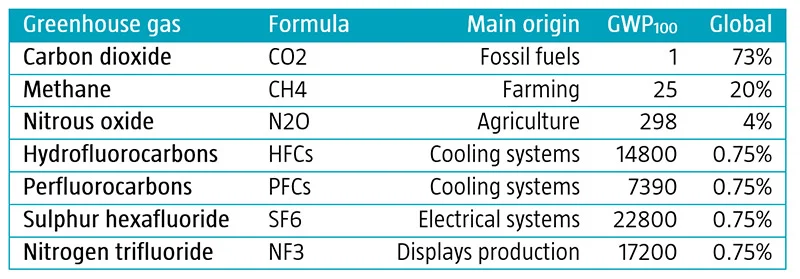When speaking about carbon emissions we often mean carbon dioxide equivalents instead of just carbon dioxide. But what does this ‘equivalent’ exactly mean? Well, carbon dioxide is not the only molecule contributing to global warming – there are many different molecules that possess greenhouse gas effects. This memo explains how this ‘equivalent’ is used to measure the effects of many different greenhouse gases together.
In the Kyoto protocol (1997), initially six different greenhouse gases were considered. These are shown as the first six gases in the table below. In 2013, nitrogen trifluoride was added as the seventh official greenhouse gas. Besides the gases in the table, ozone and water vapor are also important greenhouse gases. However, these are not included in the greenhouse gas protocol as their presence in the atmosphere is only limitedly influenced by mankind.

The different greenhouse gases in the table all have the ability to increase the temperature of the planet, though their impact substantially differs. To make the impact of the different greenhouse gases on the temperature comparable, the global warming potential (GWP) score was introduced.1 The GWP of a gas depends on how much heat the gas is able to absorb, and how the gas’s concentration decays over time.
I follow the market standard and look at warming potentials over a 100-year period. This is usually denoted as GWP100 and reported in the table for the seven Kyoto gases. The GWP is always expressed relative to carbon dioxide, of which the GWP is normalized to 1. For instance, methane has as GWP100 of 25, which implies that a ton of methane has 25 times higher effect on global warming than a ton of carbon dioxide over a 100-year period. When emitted, methane is actually much more than 25 times more potent than CO2, but it’s prevalence in the atmosphere decays much faster than CO2, which can remain in the atmosphere for thousands of years.
Please note the four very potent gases in the table, with SF6 topping the list, being 22,800 times more potent that CO2. These so-called fluorinated gases are thus extremely potent, and their increasing use is considered a rather large risk for future global warming. Much research on alternatives for the use of these gasses is currently being conducted to limit the future use of these gases.
The column ‘Global’ shows how much the seven Kyoto gases contribute to global warming. Carbon dioxide emissions are responsible for 73% of all global warming caused by mankind. Methane and nitrous oxide together account for 24% of global warming. The remaining 3% is caused by the four fluorinated gases.
In its annual survey, the CDP asks companies to break down the total reported scope 1 emissions (in tons of CO2e) into the seven Kyoto gases.2 Companies generally differ quite a lot in the gases they report CO2e figures for. Some companies only report emissions from CO2, while others also include emissions from other gasses, which can make comparisons difficult. For instance, does a lower total CO2e figure imply a cleaner company or is that company just not reporting on all Kyoto gases?
Get the latest insights
Subscribe to our newsletter for investment updates and expert analysis.
Footnotes
1 In this memo I still use the GWP’s from the IPCC 4th assessment report, although the 6th IPCC report with new GWP values has recently been published. Note that GWP’s are hard to estimate and vary through time as estimation methods improve.
2 Carbon Disclosure Project (CDP) is the organization that collects reported emission data of companies.


















